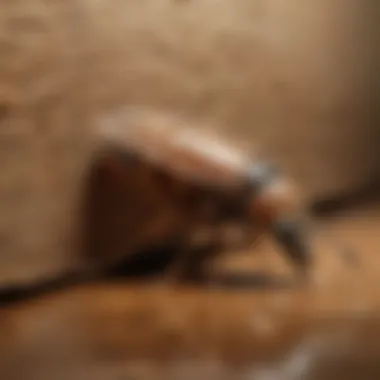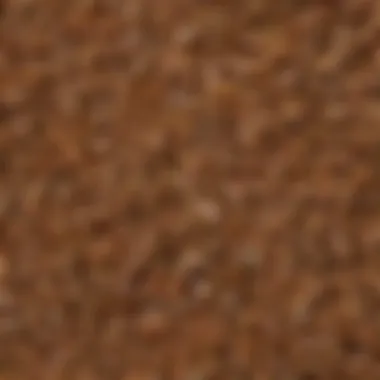Odorless Termite Treatments for Modern Pest Control


Intro
Termites are often referred to as the silent destroyers of homes and buildings. Their presence can lead to severe structural damage, resulting in costly repairs and financial losses. Thus, understanding effective pest management solutions is crucial for homeowners and property managers alike. In recent years, odorless termite treatments have emerged as an innovative way to combat these pests discreetly. This article aims to explore the various aspects of these treatments, from understanding termites to implementing various control methods effectively.
Understanding the Pest
Identification
Correct identification of termites is the first step towards effective management. There are several species of termites, but the most common include subterranean, drywood, and dampwood termites. These insects can be identified by their creamy-white bodies and straight antennae. Subterranean termites typically build mud tubes, while drywood termites often leave behind small pellets of fecal matter.
Life Cycle
To effectively manage termites, it is essential to understand their life cycle. Termites undergo complete metamorphosis, which includes the following stages:
- Egg: The female termite lays hundreds of eggs, leading to large infestations.
- Nymph: The eggs hatch into nymphs, resembling miniature adults but needing further development.
- Adult: Nymphs mature into adult termites, branching into workers, soldiers, or reproductive termites.
Understanding the various life stages helps identify the best timing for treatment interventions.
Pest Prevention Strategies
Environment Modification
Preventing termite infestations begins with modifying the environment. Consider these recommendations:
- Eliminate wood-to-soil contact by raising wooden structures or using concrete barriers.
- Keep gutters and drainage systems clear. This helps in reducing moisture that attracts termites.
- Remove dead trees, stumps, or wood remnants from the site.
- Store firewood away from the property base and ensure proper drying.
Physical Barriers
In addition to environmental modifications, installing physical barriers can significantly reduce the risk of termite access. Such barriers may include:
- Steel mesh barriers in areas most likely to attract termites.
- Silica gel or sand barriers, which can prevent termites from entering structures.
Control Methods
Chemical Control
While odorless termite treatments are becoming popular among homeowners, traditional chemical treatments still hold significant value. Chemical treatments work by applying a termiticide in the soil around the foundation. There are both repellent and non-repellent chemical options available:
- Repellent termiticides create a protective barrier against termites but may wear down over time.
- Non-repellent termiticides, like fipronil, are less detectable to termites and can spread through the colony, leading to greater efficacy.
Biological Control
Biological control methods are gaining traction as more environmentally friendly options. Common biological methods include:
- Introducing nematodes, microscopic worms that parasitize termites.
- Utilizing fungi that specifically target termite populations.
In summary, odorless termite treatments present a modern, effective approach to pest management. By understanding termites and implementing preventive strategies, homeowners can take proactive steps in protecting their properties. With ongoing advancements in pest control technology, the future holds promising solutions for dealing with these pests effectively.
Understanding Termites and Their Destructive Impact
Termites are often underestimated in regards to their potential harm. They cause severe destruction, leading to costly repairs and significant structural damage to homes and commercial buildings. Understanding termites is essential for effective pest control strategies. This section outlines their biology, behaviors, different types infesting homes, and key signs of infestation, setting the stage for the need for odorless treatments in effective pest management.
Biology and Behavior of Termites
Termites are social insects living in colonies that can contain thousands of individuals. Their life cycle consists of four stages: egg, nymph, worker, and adult. Worker termites are the primary foragers, seeking cellulose-based food sources, such as wood, paper, and plant matter. This ability to break down cellulose plays a vital role in nutrient cycling in ecosystems, yet poses a threat when they infest structures. Understanding their behavior is crucial for devising effective control methods, especially odorless ones that do not disrupt daily life.
Types of Termites Infesting Homes
Subterranean Termites
Subterranean termites account for most termite infestations in homes. They thrive underground, building extensive tunnels to reach food sources. Their distinct behavior of nesting in the soil and foraging further for wood makes them particularly effective in damaging structures. Recognizing these characteristics helps inform treatment strategies that focus on soil barriers and targeted applications.
Drywood Termites


Drywood termites are unique as they do not require contact with soil. They infest dry wood, making furniture and structural timber their primary targets. They can cause significant damage over time, often without being noticed. Their ability to thrive in wood alone underscores the necessity for practitioners to identify infestations early.
Formosan Termites
Formosan termites are considered one of the most destructive species. Originating from Asia, they have spread into many parts of the United States, forming large colonies that can consume wood faster than other types. Their key characteristic is their aggressive foraging behavior and ability to withstand extreme conditions. This makes them a major concern, necessitating immediate and effective treatment solutions.
Signs of Termite Infestation
Recognizing the signs of infestation is vital for early intervention.
Visible Damage to Wood
Visible damage to wood is one of the most telling signs of a termite problem. Termites eat wood from the inside out, leaving a thin layer of paint or wood surface intact, which can create a false sense of security. Damage may appear as hollowed-out wood, cracked or drooping areas, and even pinholes in wooden structures. Timely detection of these signs can significantly reduce repair costs.
Frass and Droppings
Frass, or termite droppings, is another clear indicator of an infestation. It often resembles sawdust or small pellets and is typically found near infested wood. Discovering frass signals active feeding, emphasizing the need for immediate pest control measures. Noticing these indicators early can help homeowners prevent wider damage.
Swarmers and Wings
Swarmers are reproductive termites that leave the mature colony to establish new nests. During certain times of the year, often in spring, they fly out in search of mates. Their discarded wings are often found near windows or light sources. Observing swarmers is a critical warning sign that a house may have an established colony nearby, prompting homeowners to take action quickly.
"Understanding the biology and behavior of termites is key to creating an effective pest management strategy."
Being knowledgeable about these aspects can aid in selecting appropriate, odorless treatment solutions that target termites without causing disruption to living spaces.
The Need for Odorless Solutions in Pest Control
The demand for odorless solutions in pest control is growing. This is due to a combination of increased awareness about health risks and dissatisfaction with traditional methods. Understanding this need is crucial for homeowners and pest control professionals seeking effective and safe ways to manage termite infestations.
Traditional treatments often involve strong chemicals. These can leave lingering smells that are unpleasant. Many homeowners are cautious about exposing their families and pets to toxic substances. Moreover, these treatments can require vacating the premises during application, which leads to disruptions in daily life. Thus, there is a collective call for methods that not only deal with pest problems effectively but also minimize any adverse effects on health.
Limitations of Traditional Treatments
Traditional termite treatments have notable limitations. Many of these methods rely on highly hazardous chemicals. While they may be effective at killing termites, their potential risk to human health is concerning. Reports of headaches, respiratory issues, and skin irritations following treatment application are not uncommon. Additionally, the residual chemicals can persist in homes for an extended period, jeopardizing indoor air quality.
Such drawbacks do not align with the modern expectations of safety and comfort. Homeowners today demand solutions that consider their well-being while ensuring a pest-free environment. The need to explore odorless solutions is evident.
Health and Environmental Concerns
Increasingly, health and environmental concerns drive choices in pest management. Many traditional pesticides contain ingredients that can negatively impact the ecosystem. If these chemicals leach into the ground, they may contaminate water supplies and harm non-target species.
For instance, studies show that certain synthetic compounds commonly used in pest control can be particularly harmful. They disrupt endocrine functions in wildlife and may contribute to broader ecological imbalances. Furthermore, families, especially those with children or vulnerable individuals, are rightfully hesitant to invite these chemicals into their home. The pressing concern for safer alternatives has paved the way for odorless treatments that prioritize health.
Benefits of Odorless Treatments
Odorless treatments provide several significant benefits, making them a favorable choice for many. They address the shortcomings of traditional methods while prioritizing safety and effectiveness.
Discreet Application
The discreet application of odorless treatments is noteworthy. This characteristic makes it appealing to homeowners who value privacy and comfort. Many people prefer not to broadcast pest problems to their neighbors. Odorless options ensure that home life continues unaffected.
These applications can blend seamlessly into one’s environment. Unlike traditional treatments, there are no overpowering smells to announce that pest control is underway. This feature enhances user comfort, allowing homeowners to maintain their usual routines without unnecessary interruptions.
Reduced Toxicity Risks
Reduced toxicity risks are another critical aspect of odorless treatments. Modern formulations are designed to minimize harmful effects. Many employ naturally sourced ingredients or less aggressive chemicals that are still effective against termites but pose fewer risks.
This approach is especially beneficial for households with children or pets, as the likelihood of exposure to harmful substances is significantly diminished. Choosing odorless methods offers peace of mind to homeowners, knowing that they are prioritizing their family's health and safety.
Minimal Disruption to Daily Life
Minimal disruption to daily life is a valuable benefit of odorless termite treatments. Traditional pest control often requires residents to vacate their homes. This preparation can be inconvenient, especially in busy households. Odorless treatments allow homeowners to stay in their homes and maintain normal activities during the treatment process.
Less disruption also accelerates recovery time, enabling families to return to their routines more quickly. This level of convenience proves appealing for many homeowners who value efficient solutions that fit into their lives.


Overview of Odorless Termite Treatment Methods
Understanding the various odorless termite treatment methods is crucial for effective pest management. These methods offer a promising alternative to traditional treatments, balancing efficacy with a need for discretion in residential and commercial settings. Understanding these options empowers homeowners and pest control professionals to make informed decisions that not only protect structures but also align with modern environmental standards.
Liquid Termiticides
Active Ingredients
Liquid termiticides serve as a primary choice for odorless termite control. The active ingredients in these solutions are designed to target termites effectively while minimizing unwanted odors. Common substances, such as fipronil and imidacloprid, are known for their systemic and long-lasting efficacy.
One significant advantage is their ability to remain in the targeted areas undetected. This allows termites to unknowingly absorb the chemicals through contact with treated wood and soil. Consequently, these active ingredients play a vital role in achieving long-term eradication of termite colonies, making them a beneficial option for homeowners.
Application Techniques
The application techniques for liquid termiticides are straightforward but require precision. Typically, a pest control professional will focus on areas prone to infestation, such as foundations or prone to moisture. Trenching and injection methods are common, which involve creating a barrier that termites cannot cross.
Moreover, these techniques allow the treatment to be hidden from view, satisfying the criteria for being odorless and minimally intrusive. The effectiveness of these methods underscores their popularity, as they can be tailored to specific structures and conditions, making them versatile solutions for many homeowners.
Bait Systems
How Baiting Works
Bait systems offer an alternative approach, relying on the innovative strategy of termite baiting. These systems involve placing bait stations around the property that contain slow-acting insecticides. Termites consume the bait and return it to their colonies. This method effectively targets the queen and other colony members, gradually leading to colony collapse.
The unique feature here is its low disruption factor, as bait stations are strategically placed outside structures. This characteristic makes them less intrusive, appealing to many homeowners who prefer discreet options for pest control.
Advantages of Bait Systems
There are several advantages associated with bait systems. To start, baiting is less likely to involve chemical exposure to residents, aligning with eco-friendly practices. Additionally, bait systems often allow for ongoing monitoring of termite activity, providing valuable information for pest management.
The self-monitoring capacity of these systems is a significant advantage. Homeowners receive peace of mind, knowing they can observe and address infestations before they escalate. Though bait systems may take longer to see results than liquid termiticides, their gradual approach can be tailored to fit various situations effectively.
Fumigation Alternatives
Controlled Atmosphere Treatments
Controlled atmosphere treatments are gaining traction as a viable alternative to traditional fumigation. This method involves altering the oxygen levels within a confined area to eliminate termite colonies. Such treatments avoid the use of chemicals entirely, appealing to those concerned about using pesticides indoors.
One key aspect of controlled atmosphere treatments is their effectiveness in treating larger infestations. They can penetrate deeply into wood and other materials, ensuring a thorough treatment. However, successfully executing these treatments requires professional expertise and proper equipment.
Heat Treatments
Another alternative is heat treatments, which use elevated temperatures to eradicate termites. This method raises the temperature of infested areas to a level that is lethal to termites.
The main benefit of heat treatments is their effectiveness without the need for chemicals or residual odor. Homeowners often find heat treatments attractive as they allow for immediate habitation after treatment. However, achieving the necessary temperatures requires specialized equipment, and it may not be suitable for all environments.
Evaluating the Efficacy of Odorless Treatments
Understanding how effective odorless treatments for termites are is crucial for those dealing with infestations. Homeowners and pest control professionals need to assess these methods to ensure they are making informed choices. Evaluating efficacy involves looking at various aspects, such as the longevity of the treatment, its ability to eliminate active infestations, and the potential for future infestations. It is essential to consider both scientific studies and anecdotal evidence when making decisions about pest management.
Field Studies and Comparisons
Field studies specific to odorless termite treatments have been conducted in many locations. These studies often compare traditional methods with modern, odorless options. Researchers measure several factors, including the rate of infestation reduction and the long-term effects of treatments.
In one study, liquid termiticides were tested alongside bait systems in residential areas known for high termite activity. Results indicated that while liquid treatments required less frequent applications, bait systems showed promising results over time due to their ability to eliminate entire colonies.
Other studies involved monitoring homes in controlled environments. Termite activity and wood damage were recorded before and after treatments. The majority of odorless methods demonstrated strong efficacy against both subterranean and drywood termites. Key findings include:
- Reduction in termite activity after following the complete treatment protocol.
- Sustained effectiveness over multiple seasons, indicating enduring performance.
- Lesser instances of re-infestation following odorless treatments compared to conventional methods.
These studies are invaluable for establishing benchmarks in odorless treatment effectiveness and for guiding future pest management practices.
Consumer Testimonials


Consumer testimonials offer another layer of insight into the effectiveness of odorless treatments. Many homeowners report satisfaction with results, citing minimal disruption during treatment procedures.
Feedback gathered from various sources, including online forums and consumer reports, provides real-world data about experiences with products like Advance Termite Bait System or Termidor. Many users have noted a decrease in visible signs of termite damage within months. Here are some common themes from these testimonials:
- Ease of Use: Consumers appreciate the straightforward application processes for many odorless treatments.
- Discreetness: The lack of overwhelming chemical smells is a significant advantage for families and residents who prefer low-odor environments.
- Long-Term Benefits: Users often comment on how they have not seen termites return, suggesting the longevity of effectiveness.
As with any product, experiences may vary. However, the overall sentiment leans towards positive outcomes when utilizing effective odorless solutions.
Safety Protocols and Best Practices
When dealing with termite treatment, especially when using odorless methods, it is essential to follow safety protocols and best practices. Adhering to these guidelines ensures not only the effectiveness of the treatment but also protects the health of those living in and around the treated areas. This section will discuss important components such as preparation for treatment and post-treatment safety measures.
Preparation for Treatment
Before any treatment begins, a thorough preparation is crucial. This phase involves assessing the property and understanding the infestation's extent. Homeowners should consider the following steps:
- Inspection: Engage professionals to inspect the premises. They can identify the type of termites and the most effective treatment.
- Clear the Area: Remove furniture, decorations, and any other personal items from the treatment zone. Creating an uncluttered space allows technicians to work efficiently.
- Seal Food and Utensils: To avoid contamination, seal food items or kitchenware. This step minimizes any unexpected exposure to treatments, even if they are odorless.
- Communicate: Inform all household members about the treatment schedule. This includes notifying pets who may need to be relocated temporarily.
By taking these preparatory actions, residents can help ensure the procedure goes smoothly.
Post-Treatment Safety Measures
After treatment, it is equally vital to observe safety measures. These practices help to maintain a safe environment and maximize the effectiveness of the odorless treatment. Recommended post-treatment measures include:
- Wait Period: Adhere to the wait period advised by the pest control company. This time allows the treatment to settle and become effective against termites.
- Do Not Disturb Treated Areas: Avoid moving furniture or altering the treated space for a minimum duration as suggested. This could interfere with the treatment's efficacy.
- Ventilation: Ensure good air circulation in the treated areas by keeping windows open, but only according to the guidelines provided by pest control.
- Follow-Up Check: Schedule follow-up inspections with professionals. This practice will reassure the effectiveness of the treatment and address any future concerns.
By following these safety protocols, homeowners can protect their health and maintain a safe living environment. It is prudent to remember that safety is a shared responsibility between homeowners and pest control professionals.
Integrated Pest Management Strategies
Integrated Pest Management (IPM) is crucial in modern termite treatment approaches. It combines various methods to achieve effective pest control while minimizing risks to health, safety, and the environment. The importance of IPM lies in its holistic view on pest management. Instead of relying solely on chemical treatments, IPM incorporates biological, physical, and environmental strategies, providing a more sustainable solution.
Benefits of Integrated Pest Management Strategies
- Reduced Chemical Use: IPM focuses on minimizing chemical applications. This reduces environmental contamination and decreases potential health risks to residents and pets.
- Long-Term Effectiveness: By integrating various control measures, IPM can provide longer-lasting results. This reduces the chances of pest resistance developing over time.
- Cost Efficiency: By preventing infestations through proactive measures, IPM can save homeowners significant costs associated with extensive treatments or repairs from termite damage.
- Safety Consideration: This approach emphasizes safety. Homeowners can feel at ease knowing that methods used are less harmful to their family and surroundings.
Combining Chemical and Non-Chemical Approaches
Combining chemical and non-chemical approaches is fundamental to successful IPM. Using both types allows pest control professionals to target the problem effectively. Chemical methods may include odorless solutions that minimize human exposure while offering swift action against termites. These treatments are effective and blend into the environment, maintaining the aesthetic of the home.
On the other hand, non-chemical methods involve physical barriers, like soil treatments or moisture control, which can prevent termites from accessing wooden structures.
Homeowners might also consider cultural controls, such as maintaining proper landscaping and ensuring wood is not in direct contact with the ground. This combination leads to a more durable defense against termite infestations.
Monitoring and Follow-Up
Effective monitoring and follow-up are vital components of any pest management strategy. After initial treatment, continual surveillance ensures that any remaining termites are identified and can be dealt with swiftly. This involves regular inspections and assessments of vulnerable areas within the home.
"Pest management does not end with treatment; it requires ongoing vigilance to ensure lasting protection."
Monitoring can be achieved with the help of bait stations strategically placed around the property. These stations not only provide a method for detection but also serve as a means for ongoing control. This method can be particularly effective in areas prone to high activity.
Follow-up evaluations might include checking for signs of infestation or damage and making necessary adjustments to both chemical and non-chemical strategies employed. By employing a routine check-up process, homeowners can maintain a secure environment, reducing the likelihood of extensive damage over time.
Integrating these strategies allows for a comprehensive approach tailored to each property's needs while ensuring a safe living space for residents.
By emphasizing the strategies of IPM, homeowners will be better equipped to make informed decisions on termite treatment and prevention, leading to healthier and safer homes.
Ending
The topic of odorless termite treatment concludes a significant chapter in pest management. Understanding the nuances of these methods is essential for homeowners and pest control professionals alike. This article sheds light on critical elements such as effectiveness, safety, and the integration of various approaches.
Future Trends in Termite Treatment
As we look ahead, the future of termite treatment appears promising. Emerging technologies are focusing on creating even more effective and safer pest management solutions. For instance, there is ongoing research into bio-based products that use naturally derived ingredients to combat termites. These options may offer both odorless applications and enhanced safety features. Moreover, innovations in monitoring systems allow property owners to track potential infestations in real-time. These advancements not only contribute to better pest management but also support environmental sustainability.
Final Thoughts on Choosing Odorless Solutions
Selecting the right approach to termite treatment requires thoughtful consideration. Odorless solutions provide an appealing alternative for those concerned with health and environmental impact. Homeowners must assess their specific situation before deciding on a treatment method. It is vital to balance efficacy with safety. Consulting with professionals who understand modern treatment options can greatly aid in this process. Investing in the right treatment can lead to lasting peace of mind, effectively protecting one’s home from destructive termites.
Opting for odorless treatments reflects a proactive approach in safeguarding both health and property.







